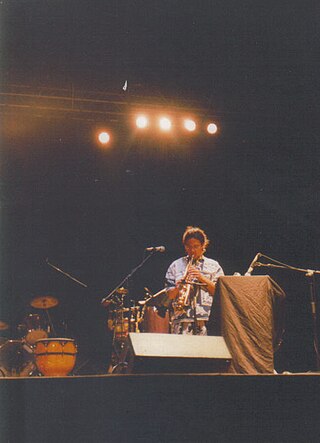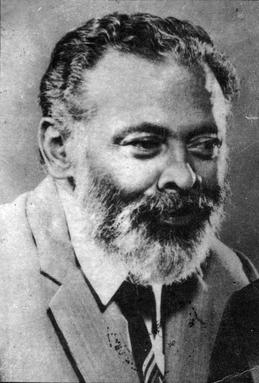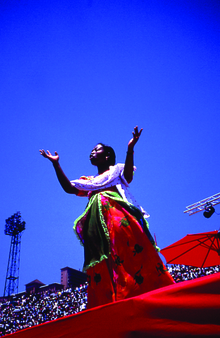
The history of Madagascar is distinguished clearly by the early isolation of the landmass from the ancient supercontinent of Pangaea, containing amongst others the African continent and the Indian subcontinent, and by the island's late colonization by human settlers from the Sunda islands and from East Africa. These two factors facilitated the evolution and survival of thousands of endemic plant and animal species, some of which have gone extinct or are currently threatened with extinction. Trade in the Indian Ocean at the time of first colonization of Madagascar was dominated by Indonesian ships, probably of Borobudur ship and K'un-lun po types.

Antananarivo, also known by its colonial shorthand form Tana, is the capital and largest city of Madagascar. The administrative area of the city, known as Antananarivo-Renivohitra, is the capital of Analamanga region. The city sits at 1,280 m (4,199 ft) above sea level in the center of the island, the highest national capital by elevation among the island countries. It has been the country's largest population center since at least the 18th century. The presidency, National Assembly, Senate and Supreme Court are located there, as are 21 diplomatic missions and the headquarters of many national and international businesses and NGOs. It has more universities, nightclubs, art venues, and medical services than any city on the island. Several national and local sports teams, including the championship-winning national rugby team, the Makis, are based here.

The highly diverse and distinctive music of Madagascar has been shaped by the musical traditions of Southeast Asia, Africa, Oceania, Arabia, England, France and the United States over time as indigenous people, immigrants, and colonists have made the island their home. Traditional instruments reflect these widespread origins: the mandoliny and kabosy owe their existence to the introduction of the guitar by early Arab or European seafarers, the ubiquitous djembe originated in mainland Africa and the valiha—the bamboo tube zither considered the national instrument of Madagascar—directly evolved from an earlier form of zither carried with the first Austronesian settlers on their outrigger canoes.

Andrianampoinimerina (1745–1810) ruled the Kingdom of Imerina on Madagascar from 1787 until his death. His reign was marked by the reunification of Imerina following 77 years of civil war, and the subsequent expansion of his kingdom into neighboring territories, thereby initiating the unification of Madagascar under Merina rule. Andrianampoinimerina is a cultural hero and holds near mythic status among the Merina people, and is considered one of the greatest military and political leaders in the history of Madagascar.

Malagasy cuisine encompasses the many diverse culinary traditions of the Indian Ocean island of Madagascar. Foods eaten in Madagascar reflect the influence of Southeast Asian, African, Oceanian, Indian, Chinese and European migrants that have settled on the island since it was first populated by seafarers from Borneo between 100 CE and 500 CE. Rice, the cornerstone of the Malagasy diet, was cultivated alongside tubers and other Southeast Asian and Oceanian staples by these earliest settlers. Their diet was supplemented by foraging and hunting wild game, which contributed to the extinction of the island's bird and mammal megafauna. These food sources were later complemented by beef in the form of zebu introduced into Madagascar by East African migrants arriving around 1,000 CE.
Malagasy mythology is rooted in oral history and has been transmitted by storytelling, notably the Andriambahoaka epic, including the Ibonia cycle. At least 6% of Madagascar are adherents of the religion, which is known as Fomba Gasy, and surveys show it is likely at least half practice some aspects of it. Adherence to Fomba Gasy is high amongst the Sakalava people, as they are reluctant to convert to faiths of foreign origin.

The culture of Madagascar reflects the origins of the Malagasy people in Southeast Asia, East Africa and Oceania. The influence of Arabs, Indians, British, French and Chinese settlers is also evident.

The architecture of Madagascar is unique in Africa, bearing strong resemblance to the construction norms and methods of Southern Borneo from which the earliest inhabitants of Madagascar are believed to have immigrated. Throughout Madagascar, the Kalimantan region of Borneo and Oceania, most traditional houses follow a rectangular rather than round form, and feature a steeply sloped, peaked roof supported by a central pillar.

The Antankarana are an ethnic group of Madagascar inhabiting the northern tip of Madagascar, around Antsiranana. Their name means "the people of the tsingy," the limestone rock formations that distinguish their traditional territory. The tsingy of the Antankarana may be visited at the Ankarana Reserve. There are over 50,000 Antakarana in Madagascar as of 2013.

Philibert Rabezoza, better known by the name Rakoto Frah, was a flautist and composer of traditional music of the central highlands of Madagascar. Born in 1923 near the capital city of Antananarivo to a poor rural family, Rakoto Frah surmounted the challenges posed by his underprivileged origins to become the most acclaimed 20th century performer of the sodina flute, one of the oldest traditional instruments on the island. Through frequent international concerts and music festival performances, he promoted the music of the highlands of Madagascar and became one of the most famous Malagasy artists, both within Madagascar and on the world music scene.

Nicolas Vatomanga Andrianaivo Rakotovao, known as Nicolas Vatomanga is a Malagasy saxophonist, flutist, bandleader and composer. His music combines elements of jazz, blues and traditional musics of Madagascar, including: the hira gasy of the Centre, the beko from the South and the salegy from the North of the Great Island.

Paul Bert Rahasimanana, better known as Rossy, is a Malagasy singer and songwriter, generally considered the most popular Malagasy artist of the 1990s. Beginning his musical career as an accordionist and singer within a traditional hira gasy musical troupe, Rossy innovated a fusion of hira gasy instrumentation and vocal style with contemporary rock, funk and folk sounds to create a uniquely Malagasy genre of contemporary popular music. Rossy actively promoted former president Didier Ratsiraka through concert performances throughout his presidency and served within the Ministry of Culture to promote artists' rights and copyright law. When Ratsiraka fell into disfavor following the contentious 2001 Malagasy presidential elections, Rossy went into self-imposed exile in France. He returned to the island to give concerts beginning in 2008 and enjoyed enormous popularity despite six years of absence, setting an unbroken record of 35,000 tickets sold for a performance given that year. His compositions and style are frequently associated with the Ratsiraka socialist period and commonly evoke a sense of nostalgia among Malagasy fans.

Erick Manana is an acoustic guitarist, singer and songwriter from Madagascar. He often performs in a duo or as a solo artist, singing in accompaniment to his acoustic guitar in the ba-gasy genre that gained prominence in the central highlands of Madagascar in the 1930s. He began to learn to play guitar and sing in the ba-gasy style from his grandfather at the age of five. In 1979 he left Madagascar to settle in France and currently lives in Bordeaux. His professional career as a musician began in 1982 as a member of Lolo sy ny Tariny. He recorded his first solo album in 1996. He was a member of the group Feo-Gasy alongside the celebrated sodina player Rakoto Frah, and together the group toured Europe several times, promoting the traditional music of the central highlands of Madagascar. He has worked on a variety of collaborative projects, recording singles and performing with established artists such as Regis Gizavo and Solorazaf, and young breakthrough stars like Aina Quash. Most recently, Manana formed a group with valiha player Justin Vali and other prominent Malagasy artists in the Malagasy All Stars.

Mahaleo is a folk-pop band from Madagascar that is widely viewed as the most popular Malagasy group of all time. The band was founded by Dama with six of his classmates after first performing together during the rotaka student protests at their high school on 13 May 1972. Mahaleo's lyrics draw upon the indirect language of traditional hainteny and ohabolana to expose contemporary political and social issues and invite listeners to identify their own solutions.
Feo-Gasy is a band from Madagascar that perform a traditional ba-gasy music of the Merina people of the rural central highlands around the capital city of Antananarivo. The band was founded in 1994 by superstar guitarist Erick Manana and featured until his 2001 death the iconic sodina player Rakoto Frah, the only Malagasy musician ever to be featured on the local currency. The group was originally composed of the acoustic guitarist and singer Erick Manana, the sodina player and singer Rakoto Frah, singer and guitarist Jean-Colbert Ranaivoarison ("Rakôly"), vocalists Famantsoa Rajaonarison ("Fafa") and François-Daniel Rabeanirainy ("Beny"), and valiha player Bariliva Rasoavatsara, who died in December 2012.

Ramilison Besigara, also known as Dadamily Besigara, was a Malagasy hiragasy troupe leader from Fenoarivo in the central highlands of Madagascar. His troupe, Tarika Ramilison Fenoarivo, featured his daughter, Perline, as a singer and dancer. Over two dozen singers, dancers and traditional musicians performed in the troupe. Tarika Ramilison Fenoarivo was in high demand to perform at famadihana reburial ceremonies and other traditional events in the highlands.
A rova is a fortified royal complex built in the central highlands of Madagascar by Merina of the Andriana (noble) class. The first rova was established at Alasora by king Andriamanelo around 1540 to protect his residence throughout a war with the neighboring Vazimba. Rovas are organized according to traditional symbolic notions of space and enclose the royal residences, the tomb of the founder, and a town square marked with a stone. They are protected with walls, trenches and stone gateways and are planted with fig trees symbolic of royalty.

Christianity in Madagascar is practiced by 85.3% of Madagascar's population according to the Pew Research Center in 2020. However, other surveys put the figure at 58%. Malagasy Christianity is generally practised in syncretic form with traditional religious practices.

Jean Verdi Salomon Razakandraina (1913–1978), commonly known as Dox, was a Malagasy writer and poet considered one of the most important literary figures in the country's history. He is principally renowned for his poetry and plays, but was also a painter, wrote and performed musical compositions, and translated several major French and English language works into Malagasy. His works have formed part of the language arts curriculum in Madagascar at every grade level since the country regained independence in 1960.
The literature of Madagascar encompasses the oral and written literary arts of the Malagasy people.
















